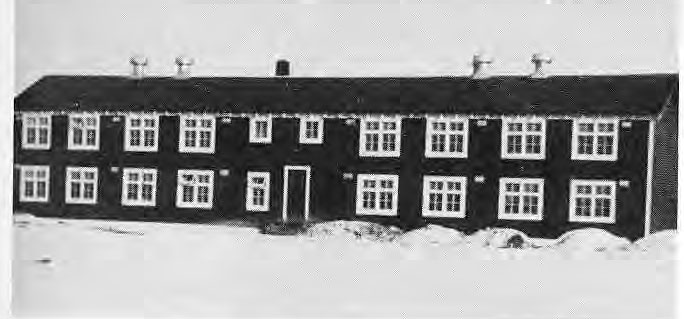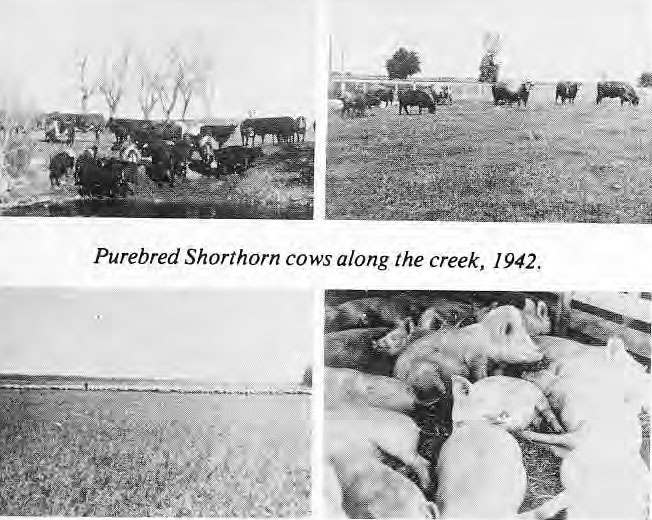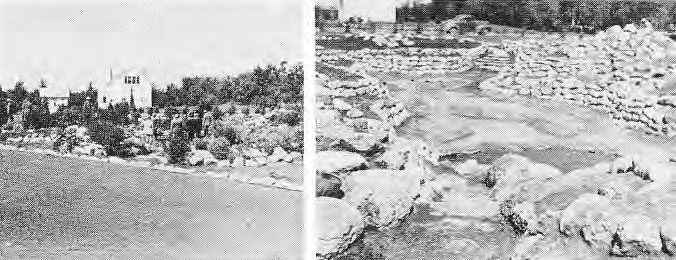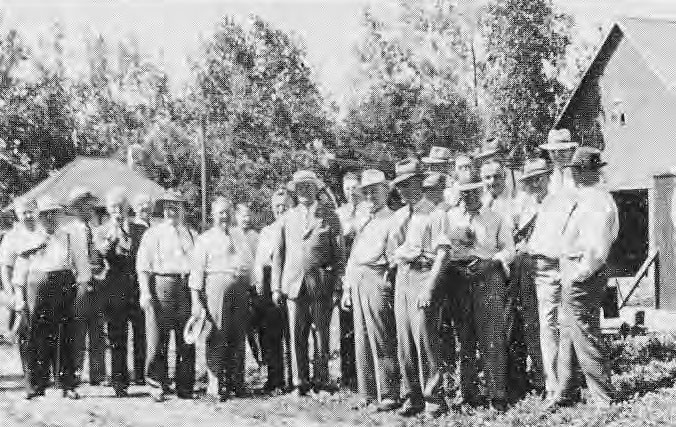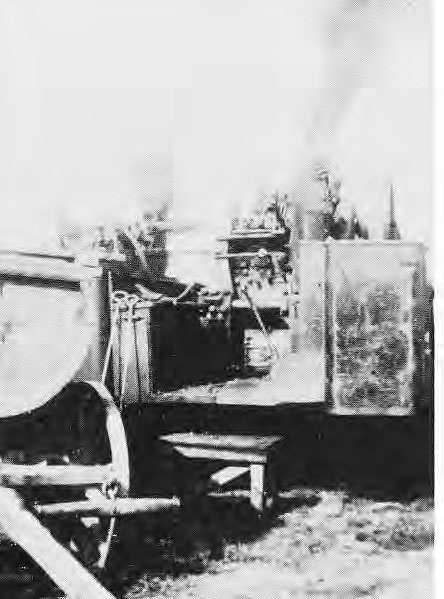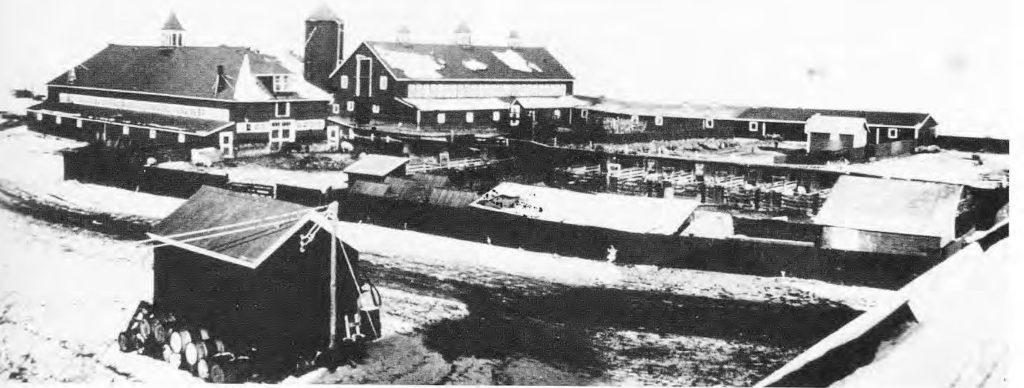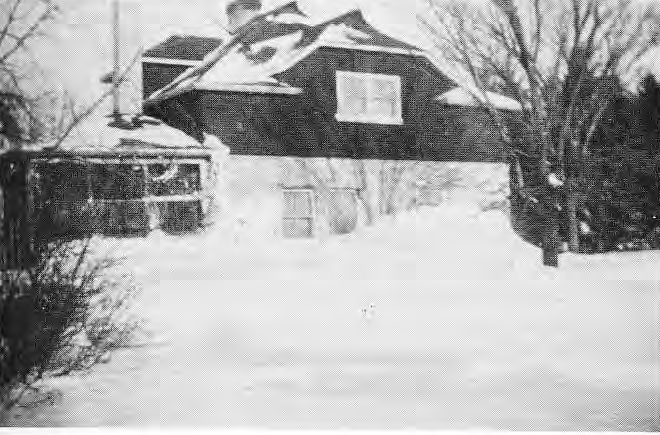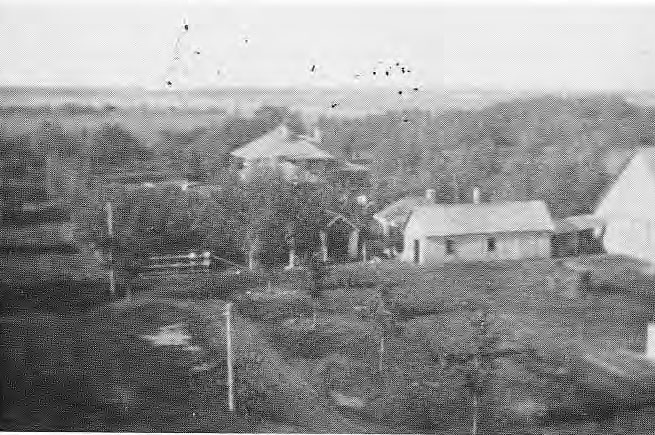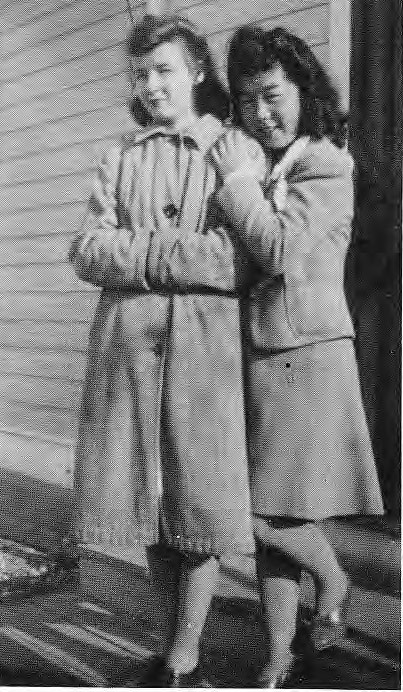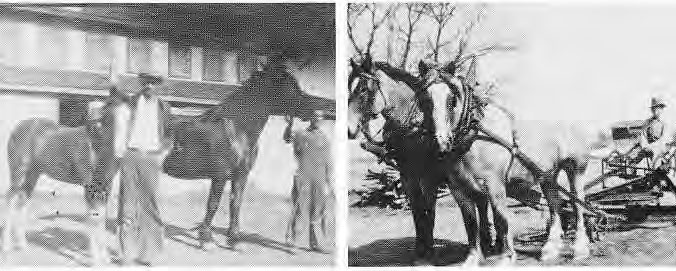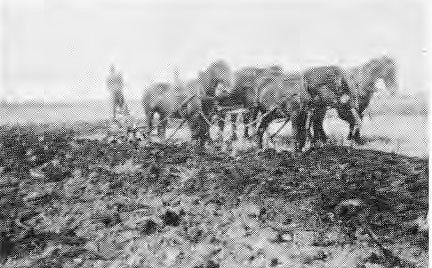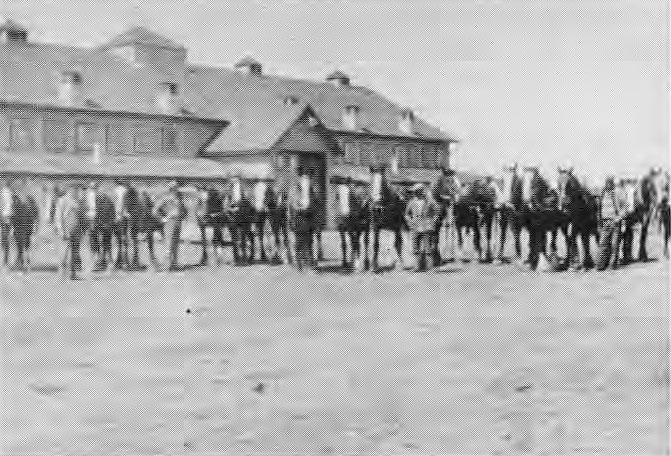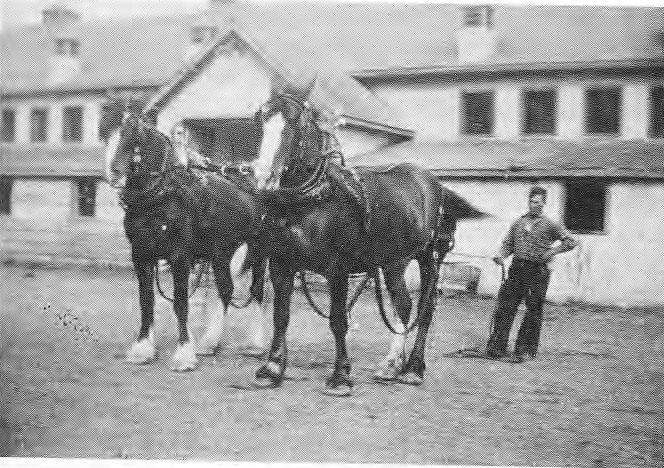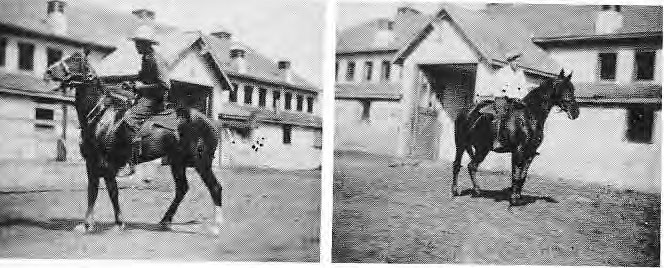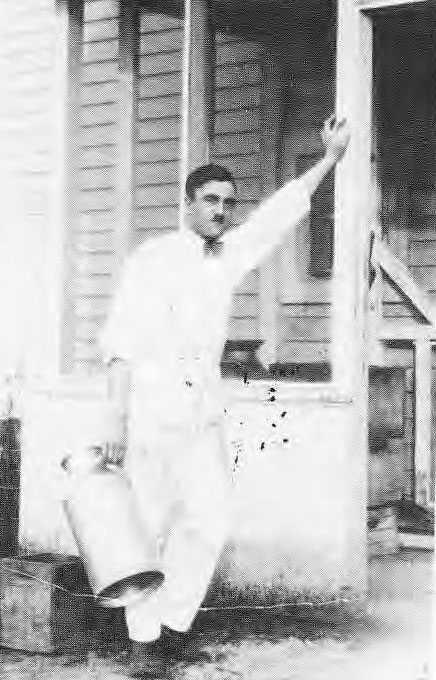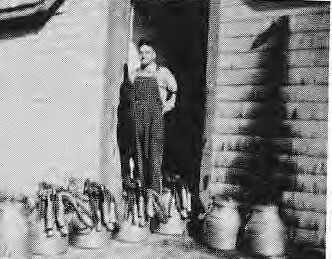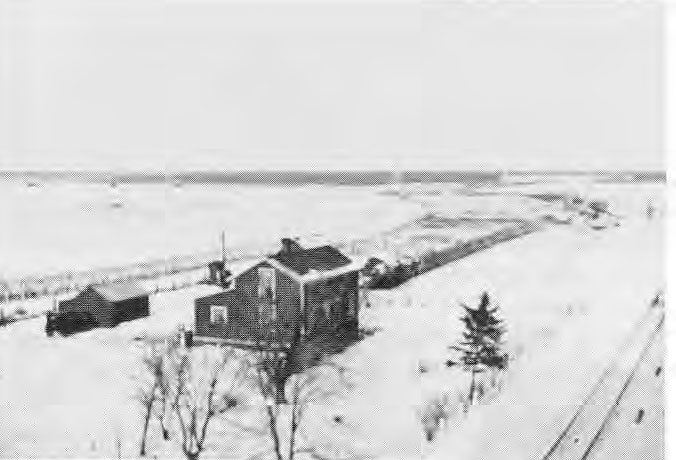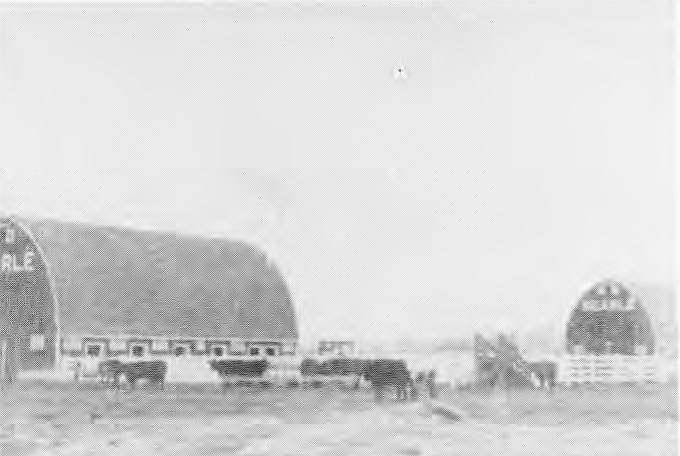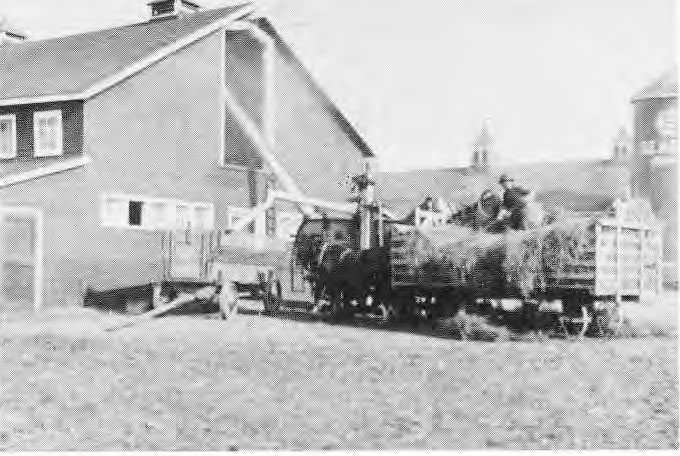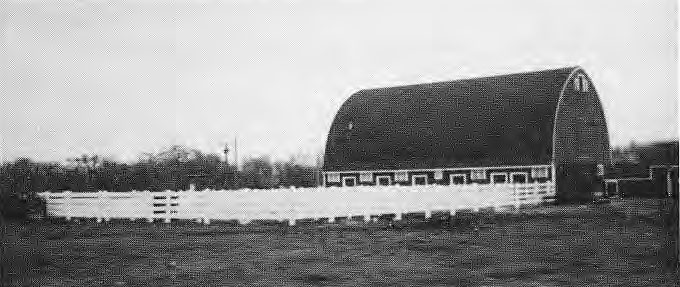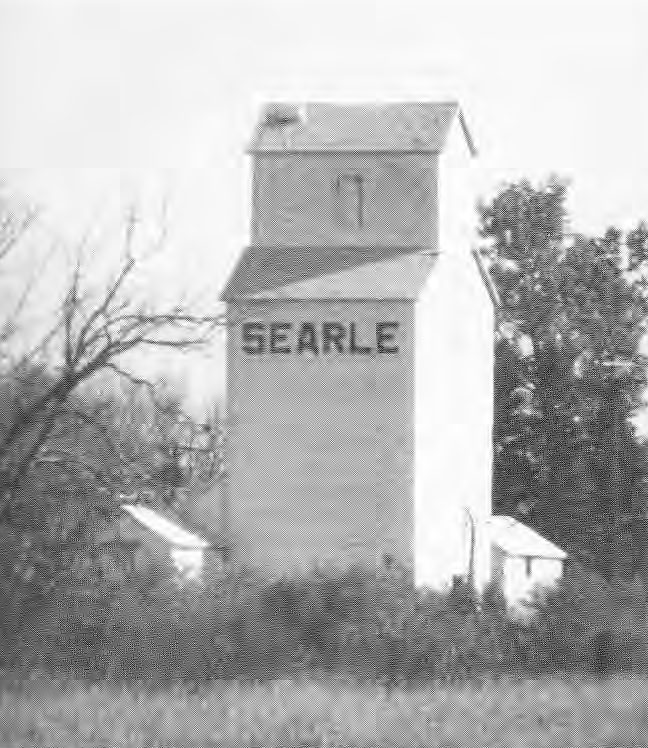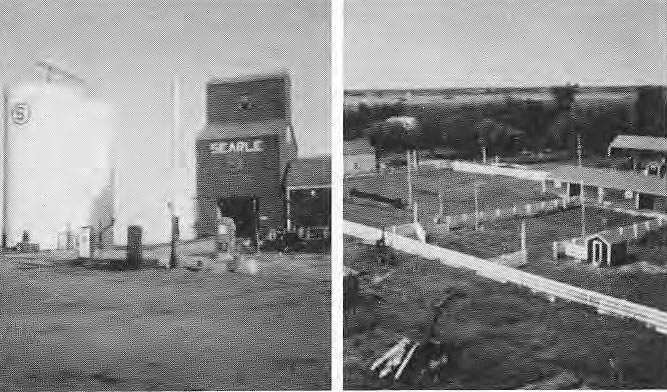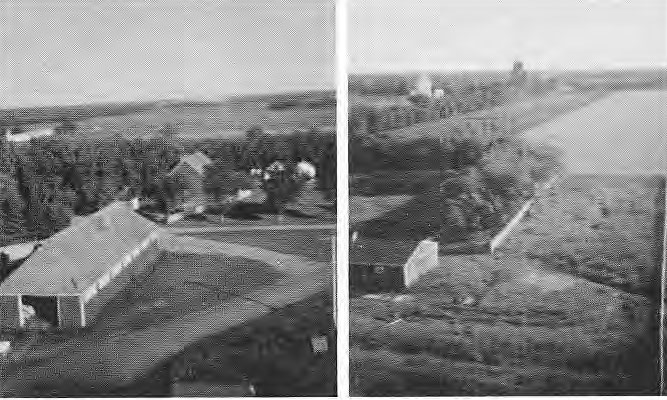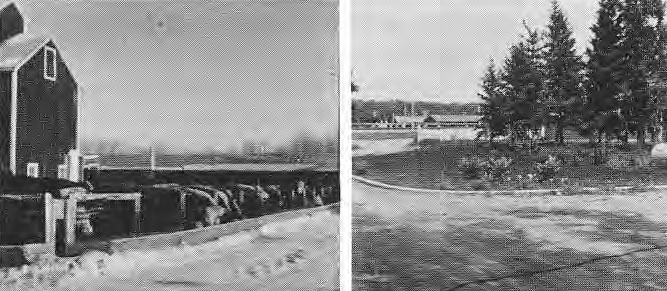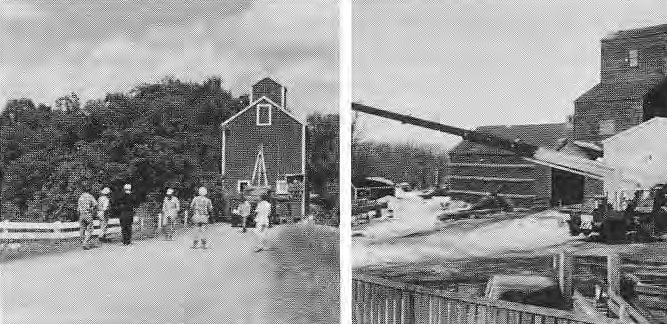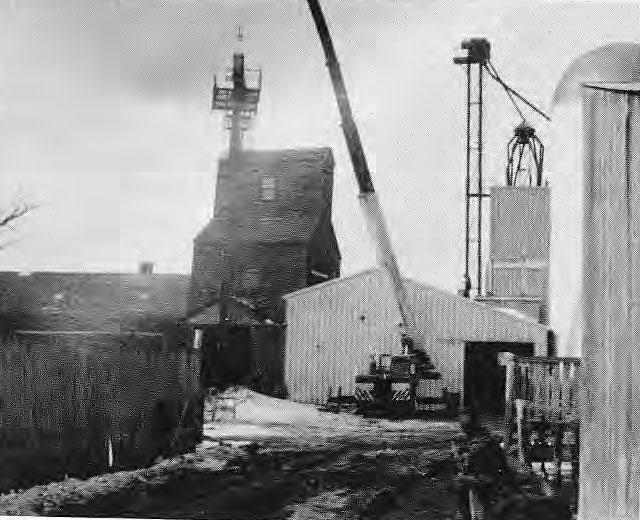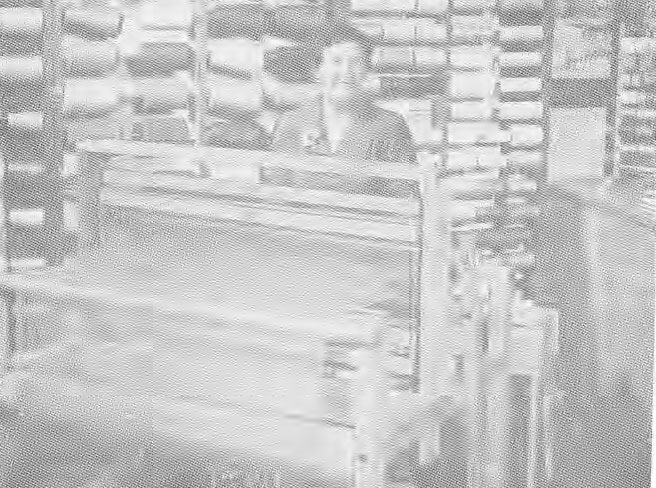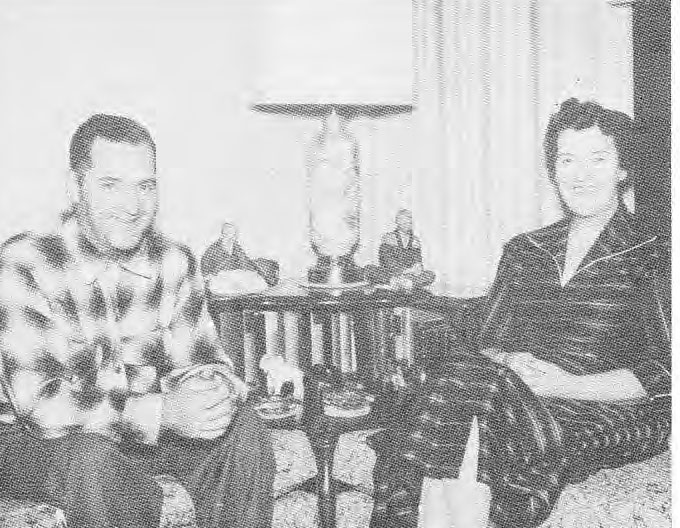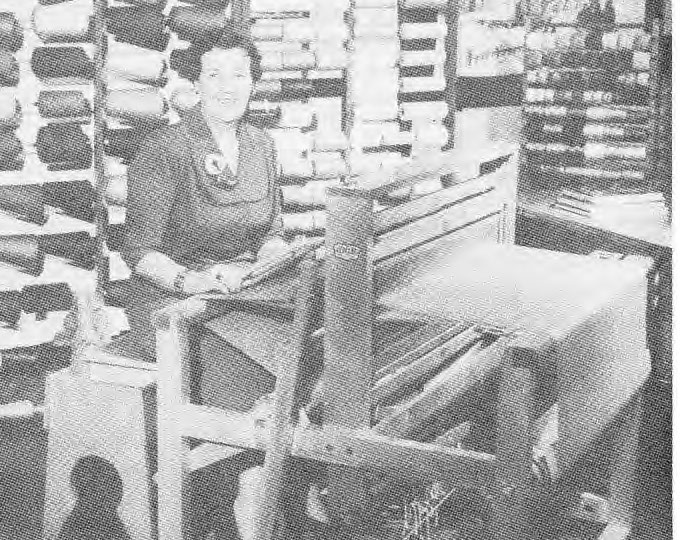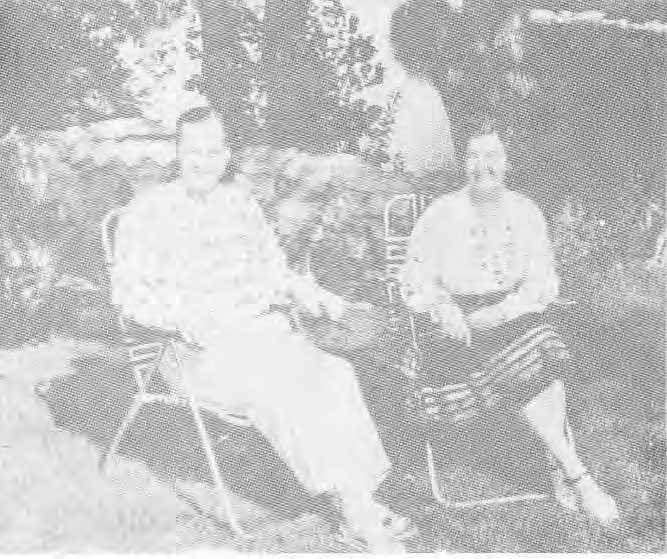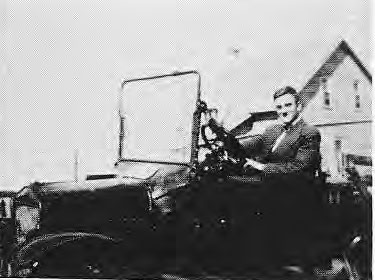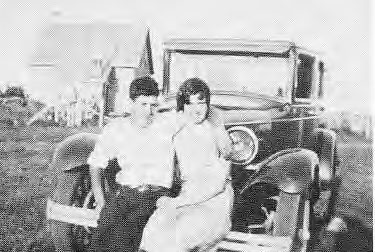By 1935, the Van Horne Farm had pretty well run its course as a showplace of Western Agriculture. Bad economic conditions, and severe drought on the prairies had combined to take its toll.
The Shorthorn herd which had been an important part of the operation, had declined in size and in quality. Purebred bulls brought $65.00 to $125.00 on average. Crops were unprofitable due to drought, rust and low grain prices. The objectives had changed. It was now a matter of financial survival using the best possible management skills. It was being operated by the Royal Trust Co. for the heirs of the Van Horne estate, and managed by the Colonization Finance Corporation, involved in the business of farm management consulting. So, the stage was set for a change in ownership. The Searle Crain Co, was a family company. President Norman L. Leach, was a son-in law of the founder, Mr. Augustus Searle, who was still active in the Minneapolis Office of the Company.
Mr. Leach was particularly interested in farming, not only because of its importance to the grain industry, but because he had a great love for the out-of-doors, and the nearness to nature that farming provided. Although he had no farm background or experience, he had more than a general interest in everything related to agriculture and the land. Other Searle directors at the time were: Mr. Stewart Searle Sr., J.M. Gilchrest, and Dave Potter.
Mr. Leach’s chief advisor on matters relating to farming was J.A. Blevens, an elevator superintendent, working out of the Wpg. Office. Jim Blevens had a farm background, being brought up on a farm in the mid-west United States. He had become familiar with Canadian farming while on a tour of duty, with the company working out of Saskatoon, as a line elevator superintendent.
When the Van Horne Farm went on the market, the Searle Grain Co., especially Norm Leach and Jim Blevens, were immediately interested. The package included 3900 acres of land at East Selkirk and all the original Van Horne buildings. About 3/4 of the land was cultivated, the rest being the Elm Grove, along the river and some native grassland left for pasture because of 300 stones. In addition, there was the history and wide reputation of the Van Horne holding’.
At the time, the farm was operated on a share crop lease basis, by a group of farmers, who were brought in from Wetaskiwin. Alta. So the deal also included some equipment, livestock, manned and operating. The lease was a 50-50 split in revenue, with the owner supplying a share of capital and operating expense. In addition to the land. This arrangement continued until the end of 1940, when Searle decided to hire a manager and operate the farm on its own.
It was Oct. 1940, when I received a call from Jim Blevens, asking if I would recommend someone qualified to become resident manager of Searle Farms. lt looked like a most interesting challenge, especially for someone in his late 20’s, an agricultural graduate with lots of farm experience. As livestock specialist for six years with the Manitoba Dept. of Agriculture, I had some knowledge of Searle Farms operation, especially their cattle herd, from which we had purchased bulls for herd improvement programs throughout the province. I decided to apply for the job, myself. Jim Blevens welcomed the idea, so we agreed on a five year contract, to set up the program and get it running.
The farm was to be operated as a separate department of the Searle Grain Co. under the direct supervision of President, Norman Leach and Superintendent, Jim Blevens. Searle also operated a very successful “Crop Testing Plan” promoting good seed development and distribution throughout the prairies. They worked closely with the line elevators and also published a regular newsletter on current agricultural topics. The director of the “Crop Testing Plan” was Major H.G.L. Strange. Mr. Leach made the decision early, that the Searle Farms would be a separate commercial farm operation and in no way involved in the activities of the “Crop Testing Plan”.
Although the Searle Farm had no involvement, it is important to note that the Searle Grain Co., in the late 1930’s, through its “Crop Testing Plan” was responsible for the importation of rust resistant Thatcher Wheat seed from growers in North Dakota and Minnesota: Many carloads of certified Thatcher were brought in and distributed in small lots to seed growers in Western Canada for multiplication. Through this program, the Searle Grain Co., was a major contributor to the successful battle against rust on the prairies. Their action gave plant breeders at the Wpg. Rust Research Laboratory time to develop rust resistant varieties of hard Spring Wheat, that in the end paved the wheat industry in Western Canada.
So, early in 1941, Searle Farms entered a new program and began to build on the Van Horne base, that had just been through the economic upheaval of the 1930’s. It was decided to stay with Shorthorns, upgrade the herd building it to about 250 head. Plans were to bring in the best bloodlines attainable. The herd would be publicized by showing at exhibitions throughout Canada and breeding stock would be made available primarily to producers and purebred breeders on the prairies.
It was decided to maintain the flock of 1000 Ewes, raising commercial lambs for the local market, and selling the wool as a by-product. Hogs were an important part of the operation. A herd of 50 sows would be maintained to produce marker hogs.
Plans called for the construction of a 1500 hen-laying house, which was accomplished by Searle Elevator Construction crew in short order. An opportunity presented itself to purchase a number of purebred Belgians from a Saskatchewan breeder, so these were added to ensure a good supply of horsepower. Hen house, 1941.
Mr. Leach was a director of the newly established Manitoba Sugar Co., so sugar beets was to be an important crop. We started out with 120 acres in 1941. Other crops were to be wheat, oats, and barley, wheat being marketed and coarse grains used mainly as livestock feed on the farm.
ln 1941, sugar beets was a new industry. We knew little about growing beets on a large scale, so we had to gain experience the hard way, but we did receive considerable help and guidance from the Manitoba Sugar Co. The first crop was quite successful. Aided by a good supply of local workers, to thin and weed, by late Sept. we had a very good stand of beets. On Sept. 28, just after lilting had begun, a foot of snow fell and all seemed to be lost. However, using a wedge-type plow the snow was moved around until we had the crop lifted. Fortunately, the weather remained mild through October. Beets were hauled to the railroad by horse and self-dumping wagons. A special homemade conveyor was used to load the cars.
By 1943, operational plans were pretty well in place. In cooperation with the Selkirk Agricultural Society, it was decided to hold a field day at the farm. The following feature article in the Family Herald and Weekly Star, by Miriam Green Ellis, Sept. 1, 1943, gives an interesting description of some of the progress that was made in the first two years of operation under outright Searle management.
The Searle farms’ story would not be complete without reference to the East Selkirk Community and its contribution to the farm operation. The beet industry in its
infancy, required a lot of hand labor for thinning, weeding, topping, and loading the beets.
ln our first year, 1941, as many as 65 to 95 daily workers were employed, mostly from East Selkirk Village, during the summer, in the beet fields.
But equally important, were the regulars, who worked full time and part time on farm jobs. Many of the men would live at home in East Selkirk, while on the Farm payroll. Later, two families of Japanese, the Shuakawa, and the Tarumoto were brought in and placed in new homes, supplied by the Federal Gov’t on the farm. It was intended that these families would work in the beet fields on contract. This was tried for a time, but their skills in other areas were soon recognized and they became an integral part of regular farm staff. Mr. Shuakawa was placed in charge of the new laying house. Mr. Tarumoto became a helper in the beef barn with Bill Donaldson. Other family members worked around the farm in carpenter work and seasonal jobs on a regular basis. Kuniko Shuakawa became a most reliable and respected employee in the managers’ residence.
As the transfer to owner-operating took place, the former tenants decided to go back to Alberta and resume farming in the Wetaskiwin area. As a result, new people were required for responsible positions on the farm.
Fortunately, Bill Donaldson, who was really the only remaining link with the prosperous Van Horne days, remained as Shorthorn herdsman. Bill, a native of East Selkirk, had worked with the former herdsman and was a very capable person to head up the new herd expansion program.
Bob and Nettie Davidson, from Spelling, Man. Moved in to run the farm boarding house. They remained until 1946. Jimmy Ross was in charge of the horse barn.
Tom Mackenzie was in charge of the sheep. He lived with his family at the easy end of the farm where the sheep were kept. Neil Church became chief mechanic in charge of tractor operations. Bob Simpson was field foreman for a while.
As these were the war years, the farm was subject to certain restraints on supplies and manpower. In cooperation with the medical staff at the Selkirk Mental Hospital, several patients were released for farm work under supervision. Three men who were successfully rehabilitated were, Towo Laaja from Elma, Man., Neil McKennon from Wpg., and Harry Whittington, a First World War veteran from England. They proved to be reliable workers and made a positive contribution around the farm.
Searle Grain Company
submitted by Goftlon Muirhead
The Searle Grain Co. operated a commercial grain elevator on the C.P.R. siding just outside the main gale of the farm. Bob Adamson was the manager of the elevator in 1940. In l94l Bob was moved to head office as a field superintendent and George Hurlmeir was named manager, a position he held until 1958. George and Marie Hurlmeir took up residence in the new managers ‘home by the elevator in 1941.
They came from Saskatoon where they had lived for 6 years having previously moved from Eston, Sask.
Jim Medal from East Selkirk was for many years the Managers’ helper at the Searle Elevator.
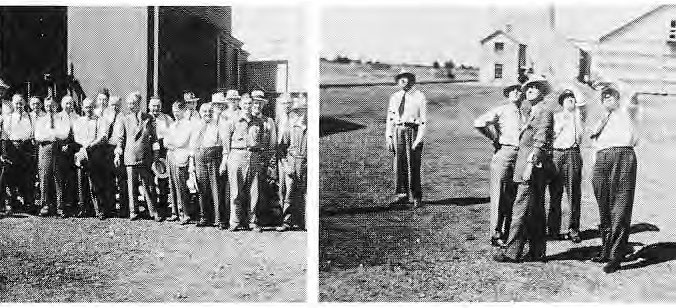
L: Dieclo B and senior staff of Searle Grain Co. visiting the farm in 1943
R: A group of visitors at the Grain Elevator
The Colbert Family 1945- 1965
Submitted by Patricia T. Colbert
The Colberts arrived at Searle Farms in September 19,15 just after the explosion at the CIL Plant where two men were killed and the community was still in a state of shock.
One entered the farmstead by crossing over the CPR main line, passing and side tracks, between the Searle Elevator and the CP Station. down a land bordered with Manitoba maples.
At the south end of the lane there was a small foreman’s house on the rest side and then corrals and a large red horse barn with lean to and hayloft, which would easily hold 60 horses, built in the early 1900’s when most farm work was done with horses.
On the east side of the lane was the rambling red cattle barn with lean-tos, annexes and lofts, and a small white separate milk house with cream separator, etc.
There was a round wooden silo attached to the cow barn. ln the summer when it was empty it would dry out and shrink and wide spaces would appear. ln the fall when the corn packed into it started to ferment the liquid would run down the sides and along the ditch by the road. It had a heady aroma to say the least.
Filling the Silo
Jim Medal, Engineer
Immediately south of that was the piggery, a long red frame building, which held around 35 sows and progeny, and was full a good part of the time . A very busy place at fallowing time.
South of the piggery $as the machine shed, machine shop and a small farm office. Also a large granary lot cleaning and storing grain, treating seed, chopping and mixing feed.
The manager’s residence and the men’s boarding house, separated by a grove of spruce trees, overlooked the lawns and gardens which were on a lower level, just above Cook’s Creek.
A driveway curved west from the manager’s residence across the CPR tracks where the section foreman Lemonson lived with his family, and our to the 2 Mile municipal road, which later became part of Highway 59. A white, two storied frame house, just above the creek. east of the road, was occupied by the Donaldson family.
South of the creek across from the Donaldson house were the two houses occupied by the Shirakawa and Taramoto families. The men were brothers-in law and had been fishermen at Steveston, B.C. but they and their families were sent to Manitoba when the government moved the Japanese from B.C. alter Japan entered the war. Mr. Shirakawa managed the poultry plant with great efficiency. He had a family of five and one wondered where they found room in the tiny house provided by the government. Hami Taramoto worked with the cattle and was definitely an asset. He had three boys and a girl June. Several of their children went to Happy Thought School, as did all the children of school age on the farm. Shirakawa’s house was moved up to just south of the Poultry house and some extra rooms added. When the Japanese Canadians were allowed to return to B.C., Shirakawa left the farm in 1949 and Taramoto in 1950. both back to fishing.
The poultry house, which was immediately west of the granary, was a two-storied, four partitioned building, suitable for carrying 2,000 hens through the laying season. The eggs were cleaned, graded and packed in crates on the premises and shipped at first by train and then later delivered by truck to customers such as Royal Alexandra Hotel, Fort Garry Hotel, Manitoba Club and Hudson’s Bay.
After Shirakawa, there were several changes of poultry men, but some stand out for their ability and length of service, such as the Carl Calden family, and the John Toews family, who worked there for some time on two different occasions. When we went to the farm in 1945 George Heirlmeier and his wife lived in the Searle elevator house and Jerry and Cathy Smith and three children lived in the CPR residence.
Mr. Simpson, who was foreman at the farm had a heart attack some days before we arrived and Neil Church, the mechanic, took over as field foreman. He and his wife Polly and three girls moved to near Niagara Falls in 1948. after which Died Reimer was foreman until 1951.
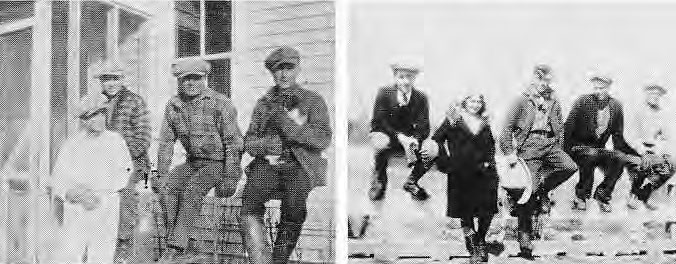
L: (left to right) “Pat” King, Bill Donaldson, Tom Walanchuk and Georges Kolinski, 1930.
R: (left to right) Walter Gordon Mrs. Walter Gordon and Bill Donaldchuk, 1932.
Left to Right: “Pat” King, Bill Donaldson, Tom Walanchuk and Georges Kolinski, 1930.
Left to Right: Walter Gordon Mrs. Walter Gordon and Bill Donaldchuk, 1932.
Bill Donaldson vas head cattleman. Alex Ross was head horseman and experienced at grooming and dressing show horses.
John Soluk, a long time resident of East Selkirk, was in charge of cleaning and treating grain, grinding and mixing feed and foreman of the fencing and clean-up crews. His employment at the farm stretched over many years. On March 19th, 1954, he and Bill Donaldson had narrow escape from death. Bob Martin, the field foreman, was driving Bill and John hone after work. The CPR day liner for Lac du Bonnet came through a few minutes late that night, the setting sun was blinding, no one saw the train, and the car was hit at the crossing near the section house. Bob Martin was killed. Bill and John Soluk were thrown out, John from the back seat of a two-door car. Neither was hurt. Bob left a wife and three little boys.
Jim Davidson and his wife were at the boarding house. Jim was a teamster and his wife a fine cook. They left the farm in l947 as Jim’s. eyesight was going.
There were many changes of cooks at the boarding house. Jean Wallace was an excellent cook and was greatly missed when she and Bill moved back to their own home after about four years at Searle Farms. The Sylvestres were there for about two years and the Parts for about three. Other names that come to mind are the Dodd and Mrs. Annis and later Mrs. Hood and Mrs. Keith.
As more houses were built on the farm and the work was more mechanized the need for a boarding house diminished. The house had reached the point where it was too expensive to repair, and $’as leveled in 1966.
Food rationing was still in effect in September 1945 and although extra quotas of sugar, tea, coffee, butter and meat could be applied for at the Ration Board, there never seemed to be enough. Many workers arrived at the farm either with no ration book or the coupons removed for some time ahead. It said a lot for the cooks who turned out such tasty satisfying meals under those conditions.
Horses The large horse barn, which had the names of long gone Clydesdales printed on the stalls, was replaced in the mid 50’s by a smaller modern barn on the south side of the Creek. and the old site covered with steer feeding pens. During the Van Horne era the horses were Clydesdales, headed by the stud and show horse ,,Lord Ardwell”. There was a well-worn, out-sized horseshoe hanging in the barn with his name under it. Many of the teamster in those days were Scots.
Cattle The farm was well-known for its Scotch Shorthorns in the Van Horne days too, starting back in 1903-04 when James Yule, a Scot and Shorthorn fancier was manager, then after his death in l911 when his son Chas. was manager, and then when J.R. Osler was manager until 1925.
For some years after that the emphasis was in other directions, but some Shorthorns still remained. After the farm was bought by Searle Crain Co. the Shorthorn herd again began to build and Searle Shorthorns competed successfully in strong competition during the 40’i and 50’s at the Toronto Royal, the Western Fair A Circuit and other fairs, usually with Bill Donaldson in charge. For several years an annual sale of Shorthorn cattle’s held at the farm and selected bulls also sold at Winnipeg, Brandon and other sales.
Eleven purebred Belgian horses were purchased from the Dr. Alexander Estate, Saskatoon in li40 and some of them and their progeny were also shown at Toronto Royal and other fairs very successfully in the 40’s and 50’s.
Unfortunately, the cost of fitting, showing and maintaining the cattle and horses as the fairs and transportation costs became prohibitive and the practice was dropped.
The Shorthorn herd outgrew the old cattle barn and many of the animals were moved to the sheds in a sheltered bend in the creek in the Rowley Field. They thrived there. Many others were also moved to the Searle Ranch, Lake Francis.
The Holstein herd was greatly enlarged and a new barn with modern milking parlor. milk Line and cooler tank was built on the south side of the creek. Continuous improvements over the years brought it to be one of the largest dairy units in the province. Some of the early dairymen in the new set up were Bill Silver, Tony Graafman, John Johnson, Joe Haldorson.
The old cattle barn was leveled and steer feeding lots were built.
In. the late 50’s an experimental program of cross. breeding of Shorthorn. Hereford and Angus cattle tor market purposes was begun. Some of the first work was done at the farm, but eventually moved to the lake Francis Ranch. The results were instructive but not necessarily conclusive. These cross _bred, along with all the purebreds were sold at what was billed as the largest private cattle Auction Sale at Lake Francis on July 6,7,8. and 9. 1965. there were 557 Hereford.. 381 Angus, and 594 Shorthorns.
The registered Belgian horses and other heavy horses, as well as cattle horses, were sold separately.
After the cattle sales were completed in July 1965 the Colbert family moved to llderton, Ont., near London, where Ab Colbert was in partnership with a brother in a Shorthorn-Holstein farm.
The East End – The Sheep Farm
Approximately 3 miles east of the main farm was the Sheep Farm, so called because there had been several hundred grade sheep there, but in 1945 only about 150 remained and were eventually all sold. Jack Purvis, a Scot and his wife and daughter lived there. The long building that had been used for sheep was the start of a swine operation. Eventually all the pig operation was moved to the Sheep Farm and the old piggery demolished.
Besides the Purvis family at the Sheep Farm other names come to mind – Annis, Charlie and Jenny Byma, Bob and Sam Bolt, Van Uden, Carl Christiansen, Hood.
The pigs at the farm were Yorkshires, many of them purebred. In the late 50’s the new Lacombe breed, developed at the Lacombe Experimental Farm, became available in limited quantities. Searle Farms were allotted several of them. They seemed to have promise but the pig market was at a very low point so the entire herd was sold in 1964. Eventually the Sheep Farm became a cattle feeding operation.
The MacLean Farm A half mile down the road from the Sheep Farm on the east side was the Mclean Farm, which was purchased from Jack Mclean and his wife. Jack was a Scot who had given up active farming on his own, but acted as foreman for the sugar beet and other work crews. Failing health caused the Mcleans to leave the farm. From then on the farm was the east end base for a tractor operator, who also oversaw cattle pastures and the cattle barn.
Names that come to mind are of Arnold Wait and family and the Geo. Keith family who lived there for extended periods.
Sugar Beets The sugar beet harvest every fall was usually a cold muddy job, much of it done by women from the village. They also did the hoeing and weeding in the summer. By about 1948 cane sugar had come back on the market in quantity and there was less demand for beets and production costs rose, so that it wasn’t economical to grow them, particularly on the heavy farm soil.
One spring beets were planted in what was called the Rowley field. We had a prolonged dry spell and the seeds didn’t germinate. Had they done so later they would not have produced a commercial crop. So the field, heavily fertilized for beets, was sown to oats. The oats grew to over 6 ft. tall and fell over from their own weight. They were difficult to harvest but yielded I l0 bus. per acre.
In 1945 there was a shortage of power machinery and I believe there was one baler, one combine and a threshing machine. Some hay was baled but most of it was raked and stacked in the old way. The thresher was used for some grain crops until more combines were available. Regular baling and binder twine was just starting to come back onto the market, but there was still some of the twisted brown paper twine around. It held fairly well but disintegrated when wet for any length of time.
Indians from the nearby reservations helped with the haying and other harvest operations. With the extra crew, at least two sittings were required for many meals at the boarding house. Boarding House and Manager’s Residence The boarding house and the manager’s residence were built of rough limestone with walls 30 ins. thick. The upper storey of each was of brown shingle, with dormer windows. Roofs were irregular with flaring curved points. At the boarding house there were three large bedrooms upstairs and a bathroom. Downstairs was a dining room which could seat 30 men in a tight squeeze, a large kitchen with a pantry and laundry room. In later years shower stalls were installed in the basement. There was a large wood burning cook stove, which miraculously turned out huge roasts, pies, cakes, etc. Dish washing was done the hard way. in the 50’s a restaurant-sized gas stove was installed, along with a dishwasher. The floors were maple, covered with heavy linoleum.
There was also a three-roomed suite on the main floor. for the use of the cook and family. There was a large lean-to at the back where boots and heavy work clothes were left and in the days before the gas stove, dry split firewood was piled.
Manager’s residence of the same construction as the boarding house but of different design. There were three large bedrooms and bath upstairs, There were three normal windows and 3 dormer windows. Some floor space was lost because of the sloping ceilings.
Downstairs was a 30′ x l5′ long double room, which originally had sliding doors between, the living room lacing south over the lawns and the dining room facing north. A 12′ x 12′ room also faced the south and a l2’x t2’kitchen faced east. There was a frame summer kitchen approximately 20′ x l4′ and a screened porch on the north side of the kitchen.
On the west side of the house was a room approximately 24’x 14’with two large windows facing west. There was a fireplace at the south end, not field stone as one would expect, but brown tile with an oak mantle. There was no second storey over this room. The stories went that when Sir Wm. Van Horne was still active he would periodically visit the farm and his private railroad car was left on the siding and this room was reserved for his use. There was a screened porch in the southwest corner of the house.
The house was heated by a huge log burning furnace, which devoured 4 ft. logs. lt heated the house fairly well but demanded frequent attention. There was a large soft water cistern in the basement and a pump in the kitchen connected to it. During a violent thunderstorm one night lightning ran down the drain pipes and split the cistern from top to bottom. The ensuing wave of water buckled the furnace and it was replaced with a propane gas furnace.
The floors throughout the house were maple, with linoleum in the kitchen. The woodwork belonged to the early 1900’s style. The story was that the two houses were designed by the architect who designed the Legislative Building in Regina, and who was a friend of Van Horne.
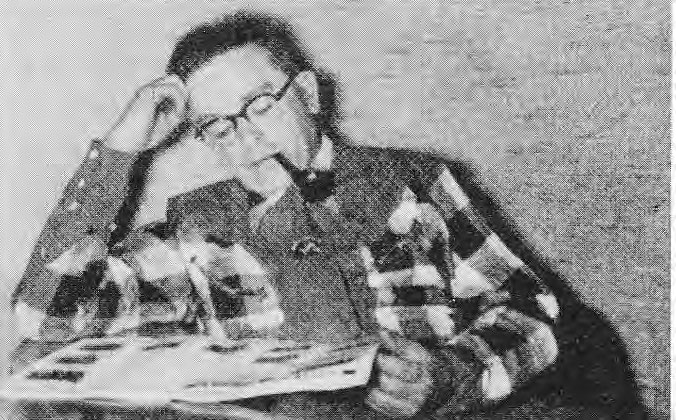
Mr. A.H.O Colbert, well know to all how have ever visited Wpg. and Searle Farms, “Ab” Colvert retired as Farm Manager–a Posistion the has held for twenty years.
There was a fieldstone parapet buttressing the driveway at the top of the lawn, done by Scottish stonemasons, as were the six foot stone posts marking the various. entrance. to the homestead
In the hey-day of the Van Horne farm there was a head gardener and six under gardeners. The results of their work still showed, even in 1945, in the form of lilacs, honeysuckle and other garden shrubs and many perennial plants in unexpected locations.
Cook’s Creek was just below the lawns and gardens. There was one deep pool that always remained after the rest of the creek was dry. When the creek was running high it was a source of some anxiety to parents with small children. [n the dry state it was a wonderful source of fossils for collectors.
On January 23rd, 1963 the manager’s residence burnt down at 4:30 in the morning. No one was hurt but the Colbert family were lucky to escape with their lives. At 25 below everything was frozen and no water was available and the Selkirk Fire Department could not service that area. We were graciously offered a home with Bill and Donna Donaldson until the new house was finished in August. it was built on the same site as the old Van Horne house. The spruce grove that stood between the residence and the boarding house was bulldozed down during the fire as there was the danger of them helping to spread the lire to other buildings.
Immigrants
From the earliest times the farm was an employer of immigrants to Canada. in the Van Horne days there were many Scots, particularly teamsters. With the tm migration Hall being in East Selkirk, many of the other Europeans found work with Van Horne and some settled in the area. In the 30’s another wave of immigrants. Alter 1945 many English, Scotch, lrish and when many Dutch, Germans, Polish and a few French, Belgians and after the Hungarian revolt, many Hungarians. Many came to the farm to work because of the stipulation they were to work in agriculture for a certain length of time, as a c0ndition of entry-v to Canada. They left the farm as soon as possible. But many stayed on because they wanted to remain in agriculture and settled in the area.
Van Horne purchased the farm in 1898, much of it from descendants of the original Selkirk settlers. The farmstead was located on l0 or l2 river lots, a rather confusing thing when asked to fill in forms asking for precise location.
Some workers at the farm in earlier years: Bob Adams, cattleman, 6 years. Toiva Laaja, gardener, 10 years until he retired. Sam Hand – cattleman – 3 years. Jack Wellock, cattleman, worked with show herd, l0 years until he died. Walter Keenan general all round worker – 6 years.
In 1945 the Searle Farm acreage was approx. 4,000 acres. When the Prov. Govt. (Manitoba Hydro) built the generating plant in the 1950’s they purchased what was called the CN angle – 140 acres, the plant site – the Elmwood property along the Red – so-called because of the giant elms on the south side of the road 1o the bridge 70 acres. and Fern wood on the north side of the road – 210 acres. For several summers Searle shorthorns were a familiar sight in the Elmwood pasture.
Searle Farms
by Frank and Danna Harbour
The farm was purchased in the late I890,s, by Sir William Van Horne for the C.P.R. as speculation when it appeared that the C.P.R. railway would cross the Red River at Selkirk; but when the railway crossed in Winnipeg, the land was turned into an experimental farm for growing wheat.
In the year 1902, Mr. James Yule took over management of the farm, and the decision was then made to establish a herd of Shorthorn cattle with a view to assisting the livestock industry and give a lead in diversified farm operations in the province of Manitoba. Sir William Van Horne allowed Mr. Yule to buy the best cattle he could find and assemble a great herd; making a splendid contribution to the Shorthorn breeding on the prairies.
In the early 1930’s, Van Horne Farm was starting to go under, and the C.P.R. would not carry the loss. To make matters worse, the crops were wiped out by grasshoppers in 1933.
In 1934, C.P.R, wanted a group to run the farm, and got the Utas family from Sweden along with a group of Swedes from Alberta to lease the farm. That year they saw a bumper crop of wheat, which later rust destroyed.
In 1936 and 1937 the-v seeded Thatcher Spring Wheat and had a bumper crop of approximately 15,000 bushels. It was sold as seed grain at approximately $4.00 per bushel.
ln 1936 the Searle Family bought Van Horne Farm from the C.P.R. and continued to lease it to the Swedes until 1937 at which time the Searle Family took over the operations.
Over the years, there were many people employed at Searle Farms from all parts of the world. During the World War 2 years when the Canadian Japanese families had to leave their west Coast homes, two families by the name of Tarumoto and Shirakowa came to work at Searle Farms. They were very diligent workers, and friendly, helpful neighbors. They returned to their west Coast homes a few years after the war was over.
Cattle have always played a very important role at Searle Farms; beginning with a registered Shorthorn herd. Throughout the years, this prominent herd saw many championships at many Canadian shows and fairs, the most note table championship being the Grand Champion, Senior Champion, and Best Shorthorn at the Toronto Royal Winter Fair in 1953. This success was achieved by Mr. A.H.O. Colbert; farm manager from 1946 1965. and herdsman Mr. William Donaldson.
1964 saw the largest dispersal sale of registered cattle in Canada, when Searle Farms sold 900 head to make way for feeder steers instead. This sale was held at Lake Francis, Man. where the Searle Grain Company had purchased extra pastureland in the 1950’s.
The early 1970’s saw the farm being sold and as such, saw the end to a portion of the history of the R.M. of ST. CLEMENTS.
Searle Farms
by Roger Saunders
My association with Searle Farms began in 1962 when Mr. Colbert hired me as field Foreman. The field operations then were mainly geared to forage production to supply the requirements of the Beef and Dairy cattle herds.
Approximately 2200 acres were in Alfalfa-grass, 250 acres in Corn and 200 or 300 acres in Oats. The remaining land was used for pasture. With 2200 acres to cut, bale and stack, haying constituted the main summer activity for the field crew. lt was during the early 1960’s, that Searle’s purchased the then revolutionary self propelled bale wagons for picking up and stacking baled hay and straw. Each machine did the work of at least 6 men and by 1963 three of these machines were in use on the farm.
ln the summer of 1963, the twin upright concrete silo’s were erected. These structures towering high above the trees and buildings still dominate the farmyard. Each fall the silo’s were filled with corn silage. As the silo’s were filled anyone climbing up to inspect the silage would be showered by stick fermenting corn juice .squirting out the doors. As thousands of gallons of corn juice flowed out the silo’s into the creek men could be observed silently pondering the possibility of collecting that juice for refinement into a more useful brew. Later on, the Silo’s were modified and used for grain storage.
The poultry operation was closed in 1963. John and Herta Toews were the last family to run this enterprise, and they moved on to manage a large poultry operation in Steinbach, Man.
ln 1964, the first moves toward large scale cattle feeding were initiated by Stewart Searle Jr. when he, Ab. Colbert, and myself visited several large feedlots in the USA. This culminated in the building of a feedmill for the preparation of complete blended rations for both the feedlot and the Dairy herd. Alterations were then made to the existing feedlot to increase capacity and facilitate mechanized bunkline feeding.
Early in 1965, a decision was made to sell the Basic Herd and to phase out the Hog enterprise. The Basic Herd consisted of over 2000 head of bulls, cows and replacement stock in three breeds, Angus, Hereford and Shorthorn. A four day auction sale was held at the Lake Francis ranch in July and all animals were sold to buyers throughout Canada and the U.S.A.
Mr. Colbert put many years and much energy into developing and building up the three herds and although he must have been sad to see them sold, he also had the satisfaction of knowing the results of his work and knowledge would benefit the hundreds of purchasers who took cattle home.
Hans Reiser spent many years as the Lake Francis Ranch foreman and did an excellent job. He and his wife, Barbara, and two daughters, moved to the East Selkirk farm for a year or so before moving to Alberta.
The Hog operation terminated in the fall, when the last hogs were marketed. Charlie Hood was the last pig herdsman. His wife Bea, was the boarding house cook, at various times. Ed Christiansen was herdsman for several years before Charlie Hood.
Mr. Colbert retired in 1965 after 20 years as Farm Manager. The Colbert’s moved to Ilderton, Ont.
I succeeded Mr. Colbert as farm Manager. At this time married Betty Anderson of Marengo, Sask. and we moved into the Manager’s residence in Aug. 1965.
In 1966, the Feedlot was enlarged with the construction of new pens for 600 head at the main yard. In addition conversion of the facilities at the Mclean farm and Rowley field into feeding pens brought total capacity up to 5000 head at any time. Bill Donaldson was Feedlot Foreman and of course, handled the job very capably
By this time the field enterprises were busy producing silage and barley for the feedlot and dairy. However, the bulk of the grain consumed in the feedlot was purchased locally from area farmers,
Dennis Howden was Field Supervisor, at this time. In later years Ken Foster and Eric Warburton, each held the Field Supervisor’s position.
It was late 1966, when the boarding house closed. By this time, the need for a boarding house was much diminished compared to previous years. This, together with the high cost of operating the facility, made closure the only logical decision. Sadly, the house was demolished in 1967 after it was decided uneconomic to renovate it.
The Dairy continued with steady improvement in production and efficiency. The success of the dairy over the years is attributable to many good employees such as Tony Graafman, Foreman, for many years, John Johnson, Lorne Meads, Joe Kuttnig now running his own dairy farm in East Selkirk, Carl Frommelt, Joe Halldorsson and, of course, many others.
Another notable event of 1966, was the March 4th blizzard. Hard packed snowdrifts filled the cattle pens to the fence tops. Two thousand head of cattle from different pens were intermingling at will. That situation really proved the value of a good branding system for cattle identification.
Long days of toil ensued opening roads, cleaning bunklines and pens in order to be able to feed the cattle. It was the fourth day before we finally punched through the McLean farm feedlot via Highway No. 59, No. 44, and No. 212. Joe Kieth had managed to drag some hay bales over drifts to the cattle but those 200 odd steers were ravenously hungry when the feed truck arrived.
Bill and Donna Donaldson sheltered and fed the passengers from the stranded Pine Falls bus for a couple of days.
Tony Graafman and his dairy crew were faced with the problem of how to milk 90 cows with the hydro off. That problem was solved when Eddy Gayleard and Clarence Mulcher had the bright idea of rigging the grain auger engine to drive the vacuum pump thus enabling the milking machines to be used.
In 1968, Searles ‘decided to offer the farm for sale as a complete going concern. After 3 years, with no buyers, it was decided to offer smaller parcels of land for sale and in 1971 land was purchased by John Martin, Ralph and Wilfred Martin, Joe and Stan Mlodzinski, Charles Wasney and Roger Saunders.
The Dairy was also sold in 1971 with the stock being sold privately to farmers throughout Manitoba. In 1973. the Feedlot and land west and east of Cooks Creek was sold to Right Angle Farms.
The land and buildings south of the Creek were used until 1977 by Searle Nurseries when it, too, was sold to Right Angle Farms. The Nursery was begun in 1966 at the West end of the Rowley field. A house was moved onto the site and a greenhouse constructed.
Bart Huisman was hired as plant propagator. In later years trees were also grown east of the highway by the creek. The old dairy buildings were utilized for the Nursery operations, after the dairy herd was sold.
During the early 1970’s, the Nursery began growing plants in containers and several acres east of the dairy barns were used for this purpose. The Nursery, except for
the greenhouse was sold in 1977 by auction.
The greenhouses are still a thriving and expanding operation producing flowers and plants. The Van Beveren family came to work at the Nursery in 1968 and still remain today as shareholders in Searle Greenhouses.
Names of some more farm employees that come to mind are: Sam Darker, Jack Liske, Jack Elder, Sam Hand, Bill Reimer, Art Tibold, Clarence Mutcher, Ken Baker, Garry Sutherland.
It can be said that Searle Farms has had a very positive impact on this area. It has provided gainful employment^ to hundreds of people, over the years. Purchases of machinery, equipment and supplies, have benefited many people, and businesses, in the area.
Right Angle Farms
submitted by Roger Saunders
Right Angle Farms was incorporated in 1973 to acquire and operate the Searle Farms property consisting of the feedlot and about 2500 acres.
The owners of Right Angle Farms were Roger and Betty Saunders and Tom and Mary Ellison. The Saunders have three children, Michael, Megan and Kyle. The Ellison’s have four children, Trish, Carol, Fiona and Tommy.
The name, Right Angle, was chosen because of the right angle curve that runs through the farm.
The Feedlot continued to operate with a capacity of 2000 head. Right Angle fed up to 500 head of its own cattle. The remainder of the lot was occupied with cattle fed for other groups on a custom basic.
The land base totaled about 2500 acres, some owned and some rented. Crops produced were; Alfalfa, corn, cereals and oilseeds.
Employees who spent several years at Right Angle were Rick and Marie Davis, Lorne MacKay, Lorne Meads, Tom Harcus, and Dave Sinclair.
Searle Handweaving
submitted by slh
In the early 1930’s, Augustus L. Searle. who was then the Chairman of the Board of Director of the Searle Grain Co. ltd. set up within the company, the Research Dept. and “Crop Testing plan,,.
In 1940 he decided to embark on a ,,home_ weaving scheme” and by April of 1942 he had the program ii place complete with a course of instruction to teach the craft of weaving. Renee Beriau, the daughter of Oscar Beriau of Quebec hand weaving fame, came to Manitoba in early 1042 to assist in the organization of the Endeavour.
Searle Grain and Miss Beriau recruited four local farm girls to be trained as Instructors. Each of these girls were fluent in English and one other language. Two of the girls spoke French: miss Helen Boiley from La Broquerie-and Miss Germaine Chaput of St. Adolphe. while the other girls: Ann Yakimischak from Winnipeg spoke Ukrainian and Russian and Miss Laura Muirhead bf Carberry spoke Swedish
After three month of raining the girls were prepared to Instruct weaving b1 April 1942. Each of there instructors were sent to teach in whatever area their language would best serve.
The-first weaving course in this program began on April 20, 1912- The courses were taught in towns or Villages which had a Searle Crain Elevator, and the local agency ret up the equipment and material when it was shipped by rail. Usually a Church basement o, town hall was used for place of instruction.
The Searle Grain asked the students in each community to form a “Farm Home Weaving Circle, ,and membership was open to any farm woman or girl interested. The course was free but the Local wearing group charged A minimal fee of 50cenrs annually to cover the incidentals of the local group. Looms and wearing equipment and raw materials were provided during instruction. Searle Grain assumed the responsibility and financial cost of the 0peratlon.
The course, usually, was of six weeks duration, ran a minimum of 2 1/2 hours per day, five days per week. One group would receive their 2 1 / 2 hours in the morning and another group were taught during the afternoon.” The instructors taught was six student per session Although the period of instruction was short . the courses .were very intensive.
The Searle Grain Co. through the formation of the Weaving Circles, also tried to keep weaving active in the community after the instructor had left by requesting that the “Circle” who had had free instruction also each freely an) farmwoman wishing learn.
In 1944, the Searle Weaving Competition was held with 200 entries being submitted. they were sent to Quebec they were judged, displayed and then returned to Winnipeg with glowing praise.
By July, 1944, 62 classes had been held, as which 794 women and girls had learned the art of weaving. These pupils purchased 246 of the 45′, looms for rural use.”. Later that year, as a result of the newly imposed gas rationing, the weaving instruction program came to a halt. Farmer. could no longer spare the gas to allow their waves to travel for such things as weaving instructor. Gas was .being used for only essential from work such as increase increased food and stock production. The wearing Instructors and their equipment and material were returned to Winnipeg.
At the same time that the Searle Grain had developed their weaving education program they also opened the Searle Farm Home Weaving Dept.. in their head office in the. Grain Exchange Building in Winnipeg. This was retail outlet for the materials and equipment needed to practice hard weaving. The Consultant of the, Dept. was Dorothy Rankine, who was responsible nor only for the Operator on of the office, bur for providing advice and assistance to weavers.
If a student of the program wished to buy her own 45,, Leclerc loom, like the one she had been taught on, she could do so, from Searle at a cost in 1942: of about $48.00, which could be bought on payments of $5.00 per month with no interest.
Dorothy Rankine had been given clear guidelines to follow in the operation of her department by Stewart A. Searle (son of Augustus), and Norman Leach, who were two of the directors of the company at the time. The message was clear, “Looms and Weaving accessories were to be sold at no profit.”
Searle also stocked a large variety of yarns for weaving. Linen was bought from Ireland and France, as were tweed yarns of fine wools from Great Britain.
The Searle weaving section had a regular monthly newsletter entitled “Searle Suggestions”, that covered a variety of topics. Dorothy Rankine included in this publication, besides a wide range of weaving information, poems, quotes, and little notes of interest that maintained a friendly contact between the weaver and the department.
Termination of the Searle Grain’s involvement with weaving occurred in two stages, The education portion of the program was disbanded in 1944, but the Farm Home Weaving Service continued for another 20 years, until the fall of 1964.
On Oct. 31, 1964 the final edition of “Searle Suggestions” was mailed out and the Weaving Dept. closed its doors. However, for 3 years afterwards, letters continued to arrive from all over the continent. Therefore, Dorothy Rankine was employed for another two years on a part time basis, working out of her home, to attend to this correspondence.
In 1965, Searle Grain and Federal Grain amalgamated. In conclusion, the Searle project of “home weaving” was a major contribution to the weaving education in Manitoba and elsewhere on the prairies during the 1940’s. Also, it was done in the true spirit and desire to better the communities they served as well as aid in the war effort. And to Dorothy Rankine, must go much of the credit and well deserved praise for her contributions and the high standard maintained throughout the years.
Van Horne Farm Memories
submitted by Gordon Muirhead
